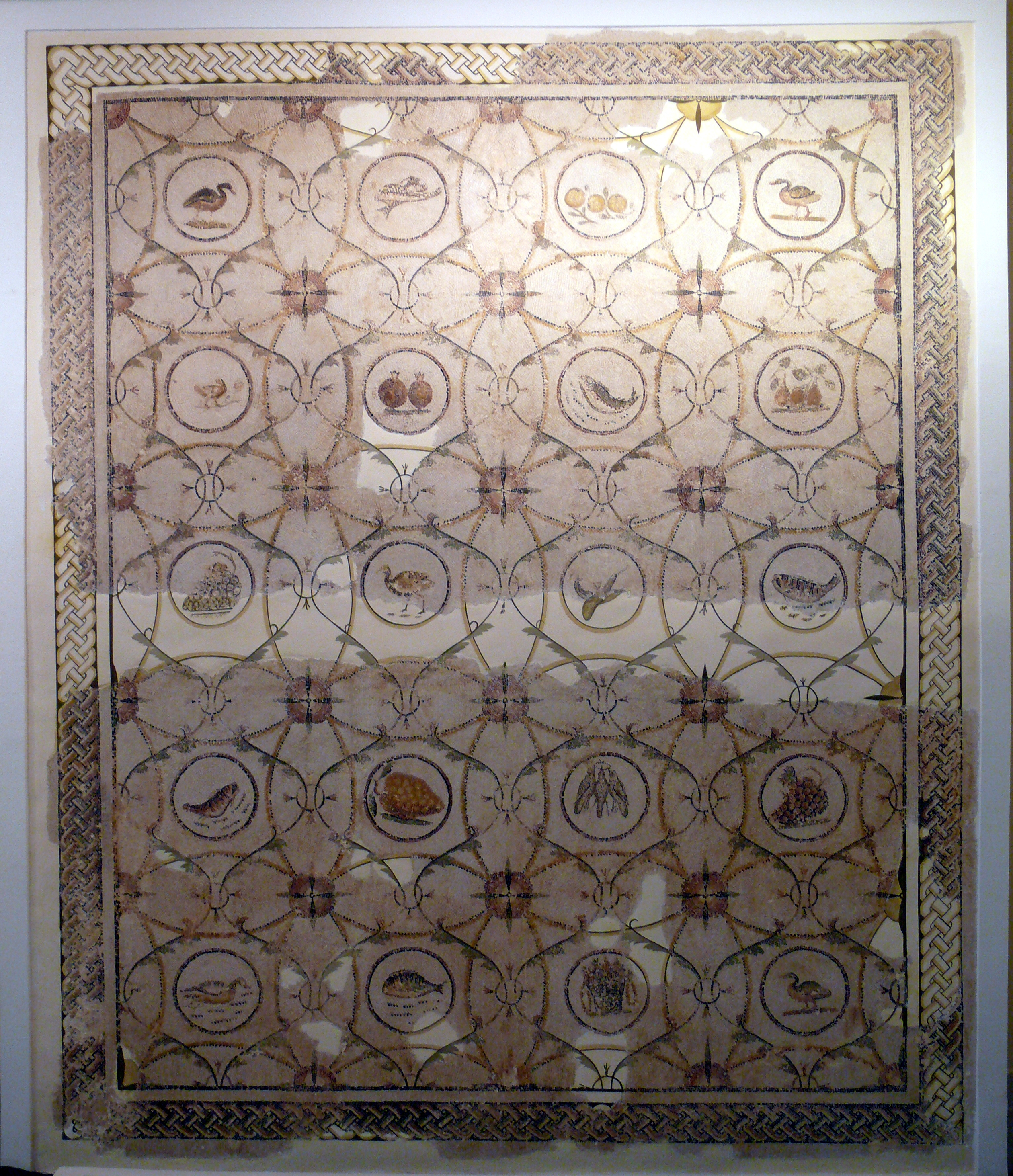Xenia Motif on:
[Wikipedia]
[Google]
[Amazon]
 The ''xenia'' motif in Roman
The ''xenia'' motif in Roman
349
Mosaic Visual motifs Ancient Roman art Iconography Genres of poetry Latin-language literature
mosaic
A mosaic is a pattern or image made of small regular or irregular pieces of colored stone, glass or ceramic, held in place by plaster/mortar, and covering a surface. Mosaics are often used as floor and wall decoration, and were particularly pop ...
is a still life
A still life (plural: still lifes) is a work of art depicting mostly wikt:inanimate, inanimate subject matter, typically commonplace objects which are either natural (food, flowers, dead animals, plants, rocks, shells, etc.) or artificiality, m ...
motif
Motif may refer to:
General concepts
* Motif (chess composition), an element of a move in the consideration of its purpose
* Motif (folkloristics), a recurring element that creates recognizable patterns in folklore and folk-art traditions
* Moti ...
consisting of a grouping of various items, mostly edible, representing a generous offering (a ''xenia'') from a wealthy host to guests. The items are often spread across different compartments in floor mosaic
A mosaic is a pattern or image made of small regular or irregular pieces of colored stone, glass or ceramic, held in place by plaster/mortar, and covering a surface. Mosaics are often used as floor and wall decoration, and were particularly pop ...
schemes. No doubt there were once paintings, but these have been lost.
Typical elements of a ''xenia'' motif include game hanging from hooks, fish, baskets of fruit (often overturned), and the like. Vitruvius
Vitruvius (; c. 80–70 BC – after c. 15 BC) was a Roman architect and engineer during the 1st century BC, known for his multi-volume work entitled '' De architectura''. He originated the idea that all buildings should have three attribut ...
lists specifically "poultry, eggs, vegetables, and other country produce".
''Xenia'' motifs are typically found in reception rooms.
The word ''xenia'' is Greek, and means ''hospitality''; in Latin, it came to mean ''presents for guests'', and later ''presents'' in general. It also came to include xenia epigrams.
A ''xenia'' epigram is an epigram
An epigram is a brief, interesting, memorable, and sometimes surprising or satirical statement. The word is derived from the Greek "inscription" from "to write on, to inscribe", and the literary device has been employed for over two mille ...
commemorating hospitality or attached to a gift, sometimes represented in a ''xenia'' mosaic. Originally found in Latin literature
Latin literature includes the essays, histories, poems, plays, and other writings written in the Latin language. The beginning of formal Latin literature dates to 240 BC, when the first stage play in Latin was performed in Rome. Latin literature ...
, it was revived in the nineteenth century.
The 13th book of Martial
Marcus Valerius Martialis (known in English as Martial ; March, between 38 and 41 AD – between 102 and 104 AD) was a Roman poet from Hispania (modern Spain) best known for his twelve books of ''Epigrams'', published in Rome between AD 86 an ...
's epigrams is entitled ''Xenia'', and catalogs the foods that might be given to a departing guest at the Saturnalia
Saturnalia is an ancient Roman festival and holiday in honour of the god Saturn, held on 17 December of the Julian calendar and later expanded with festivities through to 23 December. The holiday was celebrated with a sacrifice at the Temple o ...
.Llewelyn Morgan, ''Neither Fish nor Fowl? Metrical Selection in Martial's ''Xenia'' '', ''Harvard Studies in Classical Philology'' 103:385-406 (2007)
A Xenia epigram
:Accept and wear this constant flower, ::Thus copied out by art. :It blooms in Nature but its hour,-- ::For ever in the heart. :Affections into habits grown,-- ::Lives fastened in one lot,-- :The flower has strengthened into stone ::We name "Forget me not."Notes
References
* Katherine M.D. Dunbabin, ''Mosaics of the Greek and Roman World'', Cambridge: 1999. * Stella Grobel Miller, "A Mosaic floor from a Roman villa at Anaploga", ''Hesperia'' 41:3:332 (July 1972). *{{cite book, author=Nathaniel Langdon Frothingham, author-link=Nathaniel Langdon Frothingham, title=Metrical Pieces: Translated and Original, location=Boston, publisher=Croby, Nichols, date=1855, url=https://archive.org/details/metricalpiecest00frotgoog , quote=xenia mosaic., pag349
Mosaic Visual motifs Ancient Roman art Iconography Genres of poetry Latin-language literature